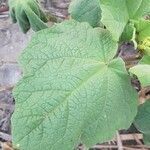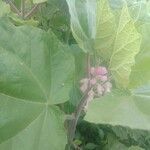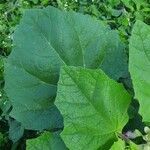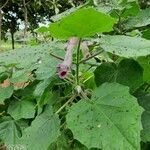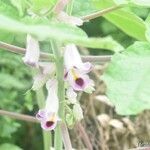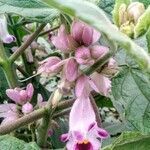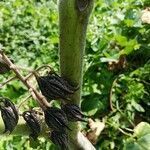| Therapeutic use
|
Anti-inflammatory agents (aerial part), Antifungal agents (flower), Common cold (flower), Wound healing (flower), Analgesics (fruit), Anticonvulsants (fruit), Antidotes (fruit), Anti-inflammatory agents (fruit), Antipyretics (fruit), Antirheumatic agents (fruit), Appetite stimulants (fruit), Burns (fruit), Common cold (fruit), Diarrhea (fruit), Eczema (fruit), Fertility agents (fruit), Goiter (fruit), Hypersensitivity (fruit), Hypnotics and sedatives (fruit), Infection (fruit), Inflammation (fruit), Insect bites and stings (fruit), Pharyngitis (fruit), Pneumonia (fruit), Scorpion stings (fruit), Skin diseases (fruit), Tuberculosis, lymph node (fruit), Wound healing (fruit), Acne vulgaris (leaf), Analgesics (leaf), Anti-bacterial agents (leaf), Anticonvulsants (leaf), Anti-infective agents, local (leaf), Anti-inflammatory agents (leaf), Antioxidants (leaf), Antirheumatic agents (leaf), Antitubercular agents (leaf), Bites and stings (leaf), Dental caries (leaf), Diarrhea (leaf), Eczema (leaf), Epilepsy (leaf), Furunculosis (leaf), Gingivitis (leaf), Infection (leaf), Pain (leaf), Periodontal diseases (leaf), Periodontitis (leaf), Pharyngitis (leaf), Scorpion stings (leaf), Skin diseases (leaf), Snake bites (leaf), Tooth diseases (leaf), Tuberculosis (leaf), Tuberculosis, lymph node (leaf), Ulcer (leaf), Wound healing (leaf), Analgesics (root), Anthelmintics (root), Antirheumatic agents (root), Common cold (root), Contraceptive agents (root), Scabies (root), Scorpion stings (root), Skin diseases (root), Tonsillitis (root), Ulcer (root), Urinary bladder diseases (root), Abscess (seed), Acne vulgaris (seed), Analgesics (seed), Anticonvulsants (seed), Antidotes (seed), Antifungal agents (seed), Antipruritics (seed), Antipyretics (seed), Antirheumatic agents (seed), Apnea (seed), Arthritis (seed), Asthma (seed), Blister (seed), Common cold (seed), Dermatitis (seed), Eczema (seed), Furunculosis (seed), Hypersensitivity (seed), Hypertension (seed), Menstruation disturbances (seed), Migraine disorders (seed), Pneumonia (seed), Pruritus (seed), Scabies (seed), Scorpion stings (seed), Skin diseases (seed), Snake bites (seed), Wound healing (seed), Wounds and injuries (seed), Furunculosis (stem), Scorpion stings (stem), Wounds and injuries (stem), Adenopathy (unspecified), Alopecia (unspecified), Carbuncle (unspecified), Epilepsy (unspecified), Inflammation (unspecified), Sore (unspecified), Sore(Throat) (unspecified), Gargle (unspecified), Scabies (unspecified), Alexiteric (unspecified), Analgesics (unspecified), Anemia (unspecified), Anticonvulsants (unspecified), Antidotes (unspecified), Anti-inflammatory agents (unspecified), Antipyretics (unspecified), Bites and stings (unspecified), Common cold (unspecified), Eczema (unspecified), Hematologic diseases (unspecified), Hypersensitivity (unspecified), Hypnotics and sedatives (unspecified), Infection (unspecified), Insect bites and stings (unspecified), Pharyngitis (unspecified), Pneumonia (unspecified), Scorpion stings (unspecified), Tuberculosis, lymph node (unspecified), Ulcer (unspecified), Wounds and injuries (unspecified), Abscess (whole plant), Anti-inflammatory agents (whole plant), Epilepsy (whole plant), Pruritus (whole plant), Skin diseases (whole plant), Tuberculosis (whole plant)
|
